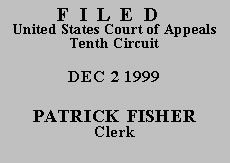 UNITED STATES COURT OF APPEALS
UNITED STATES COURT OF APPEALS
 UNITED STATES COURT OF APPEALS
UNITED STATES COURT OF APPEALS
TENTH CIRCUIT
| UNITED STATES OF AMERICA, | |
| v. | No. 99-3120 |
| CLARISSA WILLIAMSON, | (D.C. No. 93-20048-02)
(D. Kan.) |
ORDER AND JUDGMENT(*)
Before SEYMOUR, Chief Judge, BALDOCK, and HENRY, Circuit Judges.(**)
In October 1993, a jury convicted Defendant Clarissa Williamson of distribution and conspiracy to distribute crack cocaine in violation of 21 U.S.C. §§ 841(a)(1) and 846. The district court sentenced her to 292 months imprisonment. Defendant appealed and we affirmed her conviction and sentence on June 13, 1995. United States v. Williamson, 53 F.3d 1500 (10th Cir. 1995). Defendant next filed a motion in the district court to vacate, set aside, or correct her sentence pursuant to 28 U.S.C. § 2255. The Government filed a motion to summarily dismiss Defendant's § 2255 petition pursuant to Rule 4(b) of the Rules Governing § 2255 Proceedings. The Government claimed that Defendant's § 2255 petition was not timely filed.
The district court determined that the time limitations of the Antiterrorism and Effective Death Penalty Act of 1996 (AEDPA) applied to Defendant's § 2255 petition. In United States v. Simmonds, 111 F.3d 737, 746 (10th Cir. 1997), we held that "prisoners whose convictions became final on or before April 24, 1996 must file their § 2255 motions before April 24, 1997." Defendant's conviction became final on June 13, 1995 when we affirmed her conviction and sentence.(1) Defendant filed her § 2255 motion on June 23, 1998, fourteen months after the April 24, 1997 deadline. Because Defendant failed to file her § 2255 petition on or prior to April 24, 1997, the district court concluded that her petition was untimely and dismissed it. The district court denied Defendant's motion for a certificate of appealability. See 28 U.S.C. § 2253. Now before us is Defendant's renewed motion for a certificate of appealability.(2)
A defendant may appeal the denial of a § 2255 petition only if "a circuit justice or judge" issues a certificate of appealability. 28 U.S.C. § 2253(c)(1)(B). We have thoroughly reviewed Defendant's application for a certificate of appealability, her brief, the district court's order, and the entire record before us. We conclude the Defendant's petition is untimely substantially for the reasons set forth in the district court's Memorandum and Order dismissing her petition. Accordingly, we deny Defendant's request for a certificate of appealability and dismiss the appeal.
CERTIFICATE OF APPEALABILITY DENIED; APPEAL DISMISSED.
Entered for the Court,
Bobby R. Baldock
Circuit Judge
*. This order and judgment is not binding precedent, except under the doctrines of law of the case, res judicata, and collateral estoppel. The court generally disfavors the citation of orders and judgments; nevertheless, an order and judgment may be cited under the terms and conditions of 10th Cir. R. 36.3.
**. After examining the briefs and appellate record, this panel has determined unanimously to honor the parties' request for a decision on the briefs without oral argument. See Fed. R. App. P. 34(f); 10th Cir. R. 34.1(A)(2). The case is therefore ordered submitted without oral argument.
1. We have held that the judgment is not final until after the United States Supreme Court has denied review, or, if no petition for certiorari is filed, after the time for filing a petition for certiorari with the Supreme Court has passed. See Rhine v. Boone, 182 F.3d 1153, 1155-56 (10th Cir. 1999). Even including the ninety day time period for filing a petition for certiorari, Defendant's conviction became final before April 24, 1996.
2. The Tenth Circuit court clerk raised a jurisdictional issue regarding the timeliness of Defendant's appeal and referred it to the merits panel. The district court dismissed Defendant's § 2255 motion on October 22, 1998. Pursuant to Fed. R. App. P. 4(a)(1)(B), Defendant had sixty days in which to file a notice of appeal. See Rule 11 of the Rules Governing § 2255 Proceedings. The district court granted Defendant a thirty day extension of time to file a notice of appeal. On December 22, 1998 Defendant filed a motion for a certificate of appealability, which we construe as a notice of appeal. See United States v. Gonzalez,1998 WL 847638, at **1 (10th Cir. 1998) (unpublished). Accordingly, Defendant's motion, filed within ninety days of the district court's order, was timely.